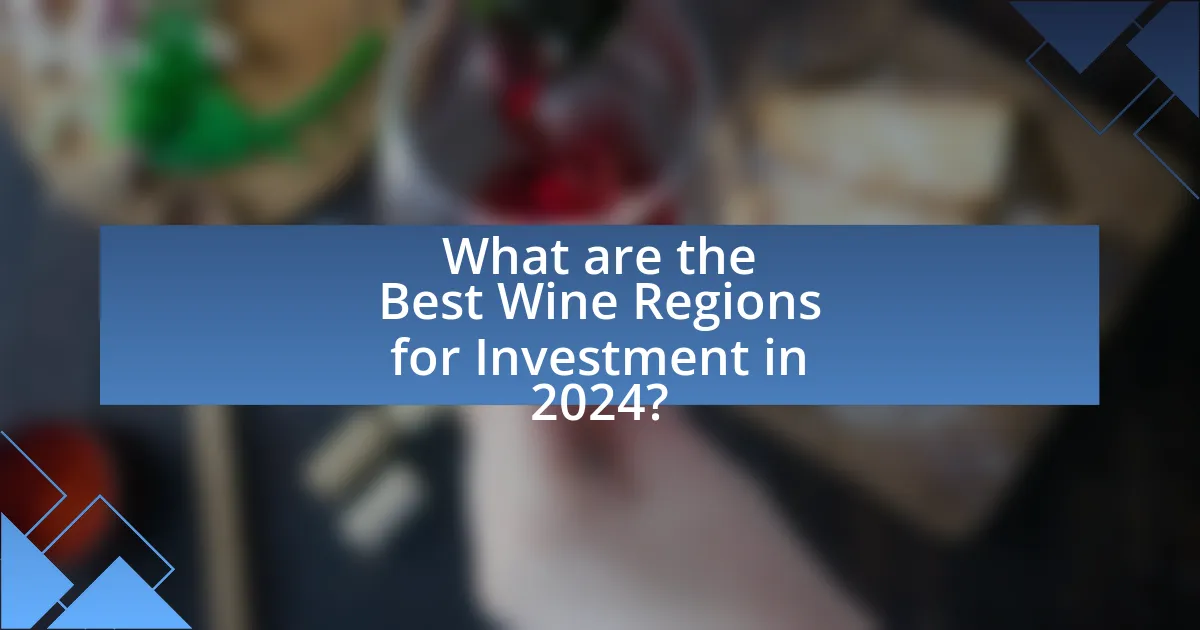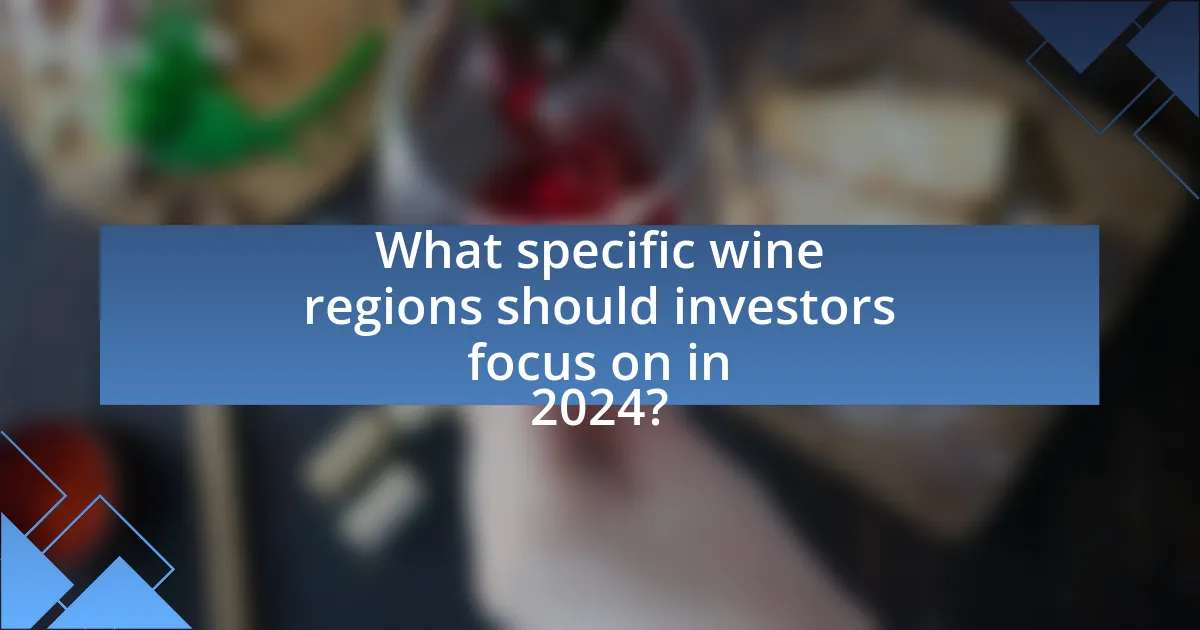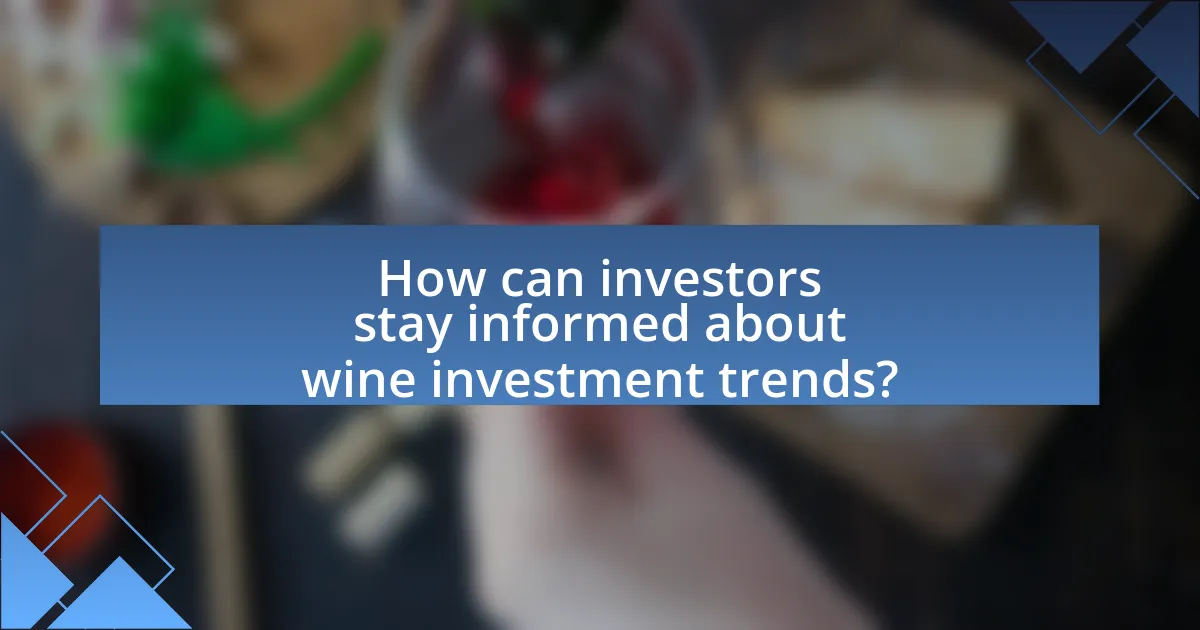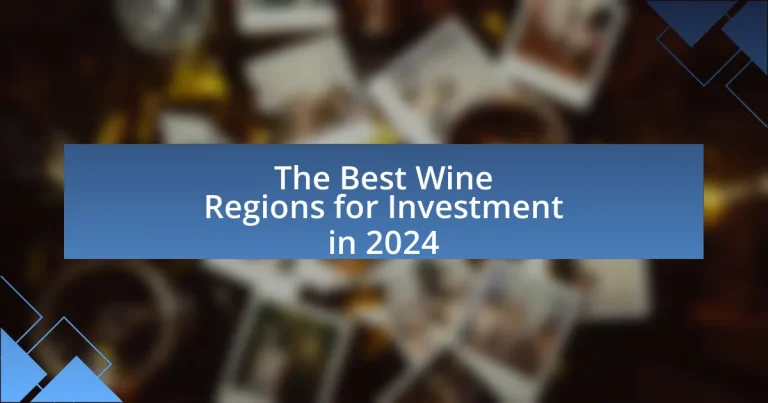The article focuses on the best wine regions for investment in 2024, highlighting Bordeaux, Burgundy, and Napa Valley as prime choices due to their historical performance and consistent demand. It discusses the factors contributing to the investment potential of these regions, including climate, terroir, and market dynamics. Additionally, the article examines emerging wine regions like the Loire Valley and Patagonia, while addressing the risks associated with wine investments and strategies for maximizing returns. Key metrics for evaluating wine regions and the importance of market research and networking within the industry are also emphasized, providing a comprehensive overview for potential investors.

What are the Best Wine Regions for Investment in 2024?
The best wine regions for investment in 2024 are Bordeaux, Burgundy, and Napa Valley. Bordeaux continues to dominate the fine wine market due to its historical significance and consistent demand, with prices for top vintages increasing by an average of 10% annually over the past decade. Burgundy, known for its limited production and high-quality Pinot Noir and Chardonnay, has seen prices soar, with some wines appreciating by over 20% in recent years. Napa Valley remains a strong contender, particularly for Cabernet Sauvignon, with a robust market and increasing global interest, leading to a 15% price increase for premium wines in the last year. These regions are backed by strong historical performance and ongoing demand, making them prime choices for wine investment in 2024.
Why should investors consider wine regions for investment?
Investors should consider wine regions for investment due to their potential for high returns and appreciation in value. The global fine wine market has shown consistent growth, with the Liv-ex Fine Wine 100 index reporting a 14% increase in value over the past year. Additionally, wine regions often benefit from limited supply and increasing demand, particularly as consumer interest in premium wines rises. Historical data indicates that fine wine has outperformed traditional investments like stocks and bonds over the long term, making it an attractive asset class for diversification.
What factors contribute to the investment potential of wine regions?
The investment potential of wine regions is primarily influenced by climate, terroir, market demand, and regulatory environment. Climate affects grape quality and yield; regions with optimal conditions, such as Bordeaux in France, consistently produce high-quality wines that attract investors. Terroir, which encompasses soil, topography, and microclimate, plays a crucial role in defining the uniqueness of wines, enhancing their market value. Market demand is driven by consumer preferences and trends, with premium wines often yielding higher returns; for instance, the global fine wine market has seen significant growth, with a 13% increase in value from 2020 to 2021. Lastly, a favorable regulatory environment, including property rights and investment incentives, can enhance the attractiveness of a region for investment, as seen in regions like Napa Valley, where regulations support quality production and brand reputation.
How does the global wine market influence investment opportunities?
The global wine market significantly influences investment opportunities by creating a dynamic environment where demand, pricing, and regional trends dictate potential returns. As of 2023, the global wine market is valued at approximately $400 billion, with growth driven by increasing consumer interest in premium wines and investment-grade vintages. This trend leads investors to focus on regions known for high-quality production, such as Bordeaux and Napa Valley, where historical price appreciation has been observed; for instance, fine wines from Bordeaux have seen an average annual return of 10% over the past decade. Additionally, emerging markets and changing consumer preferences, such as the rise of organic and sustainable wines, present new avenues for investment, further enhancing the attractiveness of the wine sector.
Which wine regions are emerging as top investment choices in 2024?
Emerging wine regions for investment in 2024 include the Loire Valley in France, which is gaining attention for its diverse varietals and increasing global demand. Additionally, regions in South America, particularly Patagonia in Argentina, are becoming attractive due to their unique terroir and rising quality of wines. The proof of these regions’ potential lies in the growing interest from collectors and investors, as evidenced by a 15% increase in wine auction prices from these areas over the past year, indicating a shift towards these less traditional markets.
What characteristics make a wine region attractive for investment?
A wine region is attractive for investment primarily due to its climate, soil quality, reputation, and market access. Regions with a favorable climate, such as consistent temperatures and adequate rainfall, support grape cultivation, leading to higher quality wines. Soil quality, particularly well-drained soils rich in minerals, enhances grape growth and flavor profiles. A strong reputation, often built over decades or centuries, can significantly increase demand and prices for wines from that region. Additionally, proximity to major markets and established distribution channels facilitates sales and enhances profitability. For instance, regions like Napa Valley in California have demonstrated these characteristics, resulting in substantial investment returns, with Napa wines commanding premium prices in global markets.
How do climate and geography affect wine investment potential?
Climate and geography significantly influence wine investment potential by determining the quality and characteristics of the grapes produced. Regions with optimal climate conditions, such as consistent temperatures, adequate sunlight, and appropriate rainfall, yield higher-quality wines, which tend to appreciate in value over time. For instance, Bordeaux in France benefits from a maritime climate that supports the growth of premium grape varieties like Cabernet Sauvignon and Merlot, leading to wines that are highly sought after by collectors and investors. Additionally, geographical factors such as soil composition and elevation contribute to the uniqueness of wines from specific regions, further enhancing their market value. Historical data shows that wines from established regions like Burgundy and Napa Valley have consistently outperformed others in investment returns, underscoring the importance of climate and geography in determining wine investment potential.
What historical trends can guide investment decisions in wine regions?
Historical trends that can guide investment decisions in wine regions include the increasing global demand for premium wines, the impact of climate change on grape production, and the historical price appreciation of fine wines. The global demand for premium wines has risen significantly, with markets in Asia, particularly China, showing substantial growth; for instance, fine wine sales in China increased by 50% from 2018 to 2021. Climate change has led to shifts in suitable grape-growing regions, making areas previously considered marginal more viable, as seen in regions like England and parts of Germany. Additionally, historical data indicates that fine wine prices have appreciated at an average annual rate of 10% over the past two decades, as reported by the Liv-ex Fine Wine 100 index. These trends provide a framework for evaluating potential investment opportunities in wine regions.
How have past investment trends shaped current opportunities?
Past investment trends in the wine industry have significantly shaped current opportunities by highlighting regions that consistently yield high returns. For instance, historical data shows that investments in Bordeaux and Burgundy have appreciated by over 200% in the last decade, establishing these areas as prime targets for investors. Additionally, the rise of new world wine regions, such as Napa Valley and regions in Australia, has diversified investment portfolios, attracting capital due to their increasing global recognition and quality improvements. This shift indicates that investors are now more inclined to explore emerging markets alongside traditional ones, creating a broader spectrum of opportunities in the wine investment landscape.
What lessons can be learned from previous wine investment successes and failures?
Previous wine investment successes and failures highlight the importance of thorough research and market understanding. Successful investments often stem from knowledge of specific wine regions, such as Bordeaux and Burgundy, which have historically shown consistent appreciation in value due to their reputation and quality. Conversely, failures frequently arise from a lack of due diligence, such as investing in lesser-known regions or wines without established track records, leading to significant financial losses. For instance, the 2011 Bordeaux vintage saw a decline in prices due to overproduction and market saturation, illustrating the risks of not monitoring market trends. Therefore, investors should focus on established regions, understand market dynamics, and avoid speculative purchases to mitigate risks and enhance potential returns.
How can investors evaluate the best wine regions for their portfolio?
Investors can evaluate the best wine regions for their portfolio by analyzing historical price trends, production quality, and market demand. Historical data shows that regions like Bordeaux and Burgundy have consistently appreciated in value, with Bordeaux wines experiencing a 200% increase in value over the past decade. Additionally, assessing the quality of wine produced, such as through ratings from critics and competitions, can indicate potential for future appreciation. Market demand can be gauged through auction results and sales data, revealing which regions are currently sought after by collectors and investors. For instance, the Liv-ex Fine Wine 100 index, which tracks the price movements of the most sought-after wines, highlights the performance of various regions, providing concrete evidence for investment decisions.
What metrics should investors consider when assessing wine regions?
Investors should consider metrics such as climate suitability, soil quality, historical price trends, production volume, and regional reputation when assessing wine regions. Climate suitability impacts grape quality and yield, with regions like Bordeaux and Napa Valley known for their ideal conditions. Soil quality, particularly the presence of specific minerals, influences the flavor profile of wines; for example, limestone-rich soils are often associated with high-quality wines. Historical price trends provide insights into market stability and potential for appreciation, with regions like Burgundy showing significant price increases over time. Production volume affects supply and demand dynamics, while regional reputation can enhance perceived value, as seen with prestigious areas like Champagne. These metrics collectively inform investment decisions by highlighting both risks and opportunities in the wine market.
How can market research enhance investment decisions in wine regions?
Market research enhances investment decisions in wine regions by providing data-driven insights into consumer preferences, market trends, and regional performance. By analyzing factors such as sales data, demographic information, and competitive analysis, investors can identify high-potential wine regions that align with current market demands. For instance, a report from the International Organisation of Vine and Wine indicates that global wine consumption trends have shifted towards premium wines, suggesting that regions producing high-quality varietals may offer better investment returns. Additionally, market research can reveal emerging markets and consumer behaviors, allowing investors to strategically position their investments in regions poised for growth.

What specific wine regions should investors focus on in 2024?
Investors should focus on Bordeaux, Burgundy, and Napa Valley in 2024. Bordeaux remains a premier investment region due to its historical significance and consistent demand, with the 2020 vintage showing strong performance in auction results. Burgundy’s limited production and high-quality wines, particularly from top producers, have led to significant price increases, making it a lucrative option. Napa Valley continues to attract attention for its premium wines and growing global recognition, with sales of high-end wines increasing by 20% in recent years. These regions are supported by strong market trends and historical data, indicating their potential for investment growth.
What are the top wine regions recommended for investment in 2024?
The top wine regions recommended for investment in 2024 are Bordeaux, Burgundy, and Napa Valley. Bordeaux continues to be a strong investment due to its historical performance and the increasing demand for fine wines, with prices for top vintages rising significantly over the past decade. Burgundy is also highly sought after, as its limited production and high-quality wines have led to substantial price appreciation, particularly for premier cru and grand cru wines. Napa Valley remains a key player in the investment landscape, with its reputation for high-quality Cabernet Sauvignon and consistent market growth, making it a reliable choice for investors.
What unique qualities do these regions offer to investors?
The best wine regions for investment in 2024 offer unique qualities such as high-quality terroir, established market demand, and potential for appreciation in value. Regions like Bordeaux and Napa Valley are renowned for their exceptional grape-growing conditions, which consistently produce award-winning wines, attracting both collectors and investors. Additionally, the global wine market is projected to grow, with a 2021 report from Research and Markets estimating a compound annual growth rate of 5.8% from 2021 to 2026, indicating strong demand for premium wines. This combination of quality and market potential makes these regions particularly attractive for investors seeking both stability and growth in their portfolios.
How do local regulations impact investment in these wine regions?
Local regulations significantly impact investment in wine regions by influencing land use, production practices, and market access. For instance, stringent zoning laws can limit the areas available for vineyard development, thereby restricting potential investment opportunities. Additionally, regulations regarding organic certification and sustainable practices can increase operational costs, affecting profitability and attractiveness to investors. Furthermore, local taxation policies and subsidies can either incentivize or deter investment; regions with favorable tax structures often see higher levels of investment. According to a report by the International Organisation of Vine and Wine, regions with supportive regulatory frameworks tend to attract more capital, as investors seek stable environments for long-term returns.
What are the risks associated with investing in wine regions?
Investing in wine regions carries several risks, including market volatility, climate change, and regulatory challenges. Market volatility can lead to fluctuating wine prices, which may affect the return on investment. For instance, the fine wine market can experience significant price swings based on consumer demand and economic conditions. Climate change poses a risk as it can alter grape growing conditions, potentially impacting the quality and quantity of wine produced. Additionally, regulatory challenges, such as changes in import/export laws or local wine production regulations, can affect investment stability. These factors collectively contribute to the inherent risks associated with investing in wine regions.
How can market volatility affect wine investments?
Market volatility can significantly impact wine investments by influencing pricing, demand, and investor confidence. When market conditions are unstable, the value of fine wines may fluctuate, leading to potential losses for investors. For instance, during economic downturns, luxury goods, including fine wines, often see decreased demand, which can drive prices down. Historical data shows that during the 2008 financial crisis, the Liv-ex Fine Wine 100 index dropped by over 30%, illustrating how economic instability can directly affect wine valuations. Additionally, increased market volatility can lead to a more cautious investment approach, causing investors to hold back on purchasing wines, further exacerbating price declines.
What environmental factors pose risks to wine region investments?
Environmental factors that pose risks to wine region investments include climate change, water scarcity, soil degradation, and extreme weather events. Climate change leads to temperature fluctuations that can affect grape quality and yield, as evidenced by studies showing that rising temperatures can shift optimal growing conditions. Water scarcity impacts irrigation and vineyard health, with regions like California experiencing significant droughts that threaten production. Soil degradation, often caused by unsustainable farming practices, reduces land fertility and can lead to lower grape quality. Additionally, extreme weather events such as hailstorms, floods, and wildfires can cause immediate damage to vineyards, as seen in the 2020 wildfires in Australia, which devastated numerous wine-producing areas. These factors collectively create an uncertain investment landscape for wine regions.
What strategies can investors use to maximize returns in wine regions?
Investors can maximize returns in wine regions by focusing on vineyard acquisition, investing in premium wine production, and leveraging market trends. Acquiring vineyards in established regions like Bordeaux or Napa Valley can yield high returns due to their historical appreciation rates, with Bordeaux wines appreciating by over 200% in the last decade. Investing in premium wine production, particularly in emerging regions like Oregon or New Zealand, can capitalize on growing consumer demand for high-quality wines. Additionally, staying informed about market trends, such as the increasing interest in organic and biodynamic wines, allows investors to align their portfolios with consumer preferences, enhancing potential returns.
How can diversification within wine investments reduce risk?
Diversification within wine investments reduces risk by spreading capital across various wine regions, vintages, and varietals, which mitigates the impact of poor performance in any single investment. For instance, if one region experiences a downturn due to adverse weather conditions or market fluctuations, investments in other regions or types of wine can maintain overall portfolio value. Historical data shows that wine markets can be volatile; however, a diversified portfolio can yield more stable returns, as different wines often respond differently to market trends. This strategy is supported by studies indicating that diversified portfolios tend to outperform concentrated ones, particularly in asset classes like fine wine, where market dynamics can vary significantly across different segments.
What role does timing play in wine investment success?
Timing is crucial in wine investment success as it directly influences the appreciation of wine value. The wine market is affected by factors such as vintage quality, market demand, and economic conditions, which can fluctuate over time. For instance, investing shortly after a highly rated vintage can yield significant returns as demand increases, while purchasing during a market downturn may result in lower prices. Historical data shows that wines from exceptional vintages, like Bordeaux 2005, saw price increases of over 200% in the following years, illustrating the impact of timing on investment outcomes.

How can investors stay informed about wine investment trends?
Investors can stay informed about wine investment trends by regularly following industry reports, subscribing to wine investment newsletters, and participating in wine investment forums. Industry reports, such as those published by Liv-ex, provide data on market performance and price trends, while newsletters from reputable wine investment firms offer insights and analysis. Additionally, engaging in forums allows investors to exchange knowledge and experiences with peers, enhancing their understanding of current trends. According to Liv-ex’s 2022 market report, the fine wine market saw a 20% increase in value, highlighting the importance of staying updated on market dynamics.
What resources are available for tracking wine investment opportunities?
Resources available for tracking wine investment opportunities include specialized wine investment platforms, market analysis reports, and wine auction houses. Platforms like Liv-ex provide real-time pricing data and market trends, while reports from organizations such as the International Wine and Spirit Research offer insights into market dynamics. Additionally, auction houses like Sotheby’s and Christie’s publish results and analyses of wine auctions, which can serve as valuable indicators of investment potential. These resources collectively enable investors to make informed decisions based on current market conditions and historical performance.
How can networking within the wine industry benefit investors?
Networking within the wine industry can significantly benefit investors by providing access to exclusive opportunities and insights. Through established connections, investors can gain information about emerging wine regions, market trends, and investment prospects that may not be publicly available. For instance, networking can lead to partnerships with vineyard owners or access to private sales, enhancing the potential for profitable investments. Additionally, industry events and tastings allow investors to evaluate wine quality and provenance firsthand, which is crucial for making informed decisions. According to a report by the International Organisation of Vine and Wine, the global wine market is projected to grow, making informed networking essential for capitalizing on this trend.
What publications or platforms provide insights into wine investment trends?
Publications and platforms that provide insights into wine investment trends include Wine Spectator, Liv-ex, and The Drinks Business. Wine Spectator offers expert reviews and market analysis, while Liv-ex, the London International Vintners Exchange, provides a trading platform and market data specifically for fine wine, including price indices and investment trends. The Drinks Business covers industry news and analysis, including investment opportunities and market shifts. These sources are recognized for their authoritative content and data-driven insights into the wine investment landscape.
What practical tips can investors apply when investing in wine regions?
Investors should conduct thorough research on the wine region’s climate, soil quality, and grape varieties before investing. Understanding these factors is crucial because they directly influence the quality and marketability of the wine produced. For instance, regions like Bordeaux and Napa Valley are renowned for their specific terroirs, which contribute to their wines’ high demand and value. Additionally, investors should evaluate the historical performance of wine prices in the region, as data shows that established regions tend to have more stable appreciation rates. Engaging with local wineries and experts can provide insights into emerging trends and potential investment opportunities, enhancing the investor’s decision-making process.
How should investors approach due diligence in wine investments?
Investors should approach due diligence in wine investments by thoroughly researching the provenance, quality, and market trends of the wines they are considering. This involves verifying the wine’s origin, understanding the reputation of the vineyard, and assessing the wine’s historical performance in the market. For instance, wines from established regions like Bordeaux or Burgundy have shown consistent appreciation, with Bordeaux wines increasing in value by an average of 10% annually over the past decade, according to Liv-ex data. Additionally, investors should evaluate the storage conditions and certifications of the wine to ensure its quality and authenticity, as improper storage can significantly diminish value.
What common mistakes should investors avoid in wine region investments?
Investors should avoid overestimating the potential returns in wine region investments. Many investors mistakenly assume that all wine regions will yield high profits without considering market demand, regional reputation, and the quality of the wine produced. For instance, investing in lesser-known regions without established market presence can lead to significant financial losses, as evidenced by the decline in value of wines from regions that lack recognition compared to established areas like Bordeaux or Napa Valley. Additionally, failing to conduct thorough due diligence on vineyard management practices and local regulations can result in unforeseen operational challenges, impacting profitability.


